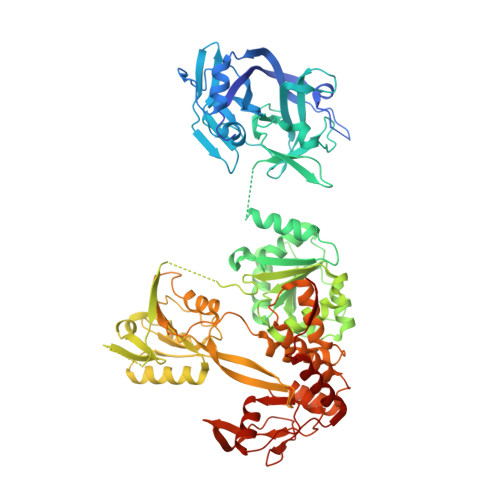A positive-strand RNA virus uses alternative protein-protein interactions within a viral protease/cofactor complex to switch between RNA replication and virion morphogenesis.
Dubrau, D., Tortorici, M.A., Rey, F.A., Tautz, N.(2017) PLoS Pathog 13: e1006134-e1006134
- PubMed: 28151973
- DOI: https://doi.org/10.1371/journal.ppat.1006134
- Primary Citation of Related Structures:
5MZ4 - PubMed Abstract:
The viruses of the family Flaviviridae possess a positive-strand RNA genome and express a single polyprotein which is processed into functional proteins. Initially, the nonstructural (NS) proteins, which are not part of the virions, form complexes capable of genome replication. Later on, the NS proteins also play a critical role in virion formation. The molecular basis to understand how the same proteins form different complexes required in both processes is so far unknown. For pestiviruses, uncleaved NS2-3 is essential for virion morphogenesis while NS3 is required for RNA replication but is not functional in viral assembly. Recently, we identified two gain of function mutations, located in the C-terminal region of NS2 and in the serine protease domain of NS3 (NS3 residue 132), which allow NS2 and NS3 to substitute for uncleaved NS2-3 in particle assembly. We report here the crystal structure of pestivirus NS3-4A showing that the NS3 residue 132 maps to a surface patch interacting with the C-terminal region of NS4A (NS4A-kink region) suggesting a critical role of this contact in virion morphogenesis. We show that destabilization of this interaction, either by alanine exchanges at this NS3/4A-kink interface, led to a gain of function of the NS3/4A complex in particle formation. In contrast, RNA replication and thus replicase assembly requires a stable association between NS3 and the NS4A-kink region. Thus, we propose that two variants of NS3/4A complexes exist in pestivirus infected cells each representing a basic building block required for either RNA replication or virion morphogenesis. This could be further corroborated by trans-complementation studies with a replication-defective NS3/4A double mutant that was still functional in viral assembly. Our observations illustrate the presence of alternative overlapping surfaces providing different contacts between the same proteins, allowing the switch from RNA replication to virion formation.
Organizational Affiliation:
Institute of Virology and Cell Biology, University of Luebeck, Luebeck, Germany.














